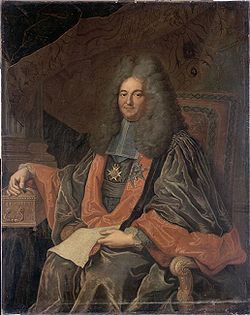
Joseph Fleuriau d'Armenonville
Encyclopedia

France
The French Republic , The French Republic , The French Republic , (commonly known as France , is a unitary semi-presidential republic in Western Europe with several overseas territories and islands located on other continents and in the Indian, Pacific, and Atlantic oceans. Metropolitan France...
politician
Politician
A politician, political leader, or political figure is an individual who is involved in influencing public policy and decision making...
.
Fleuriau d'Armenonville was born in Paris and obtained a place in government service in 1683 through his brother-in-law, Claude Le Peletier de Morfontaine, then Controller-General of Finances
Controller-General of Finances
The Controller-General of Finances was the name of the minister in charge of finances in France from 1661 to 1791. The position replaced the former position of Superintendent of Finances , which was abolished with the downfall of Nicolas Fouquet.- History :The term "contrôleur général" in...
. He served in the financial administration until 1689 when he purchased a post as councillor serving with the Parlement
Parlement
Parlements were regional legislative bodies in Ancien Régime France.The political institutions of the Parlement in Ancien Régime France developed out of the previous council of the king, the Conseil du roi or curia regis, and consequently had ancient and customary rights of consultation and...
at Metz
Metz
Metz is a city in the northeast of France located at the confluence of the Moselle and the Seille rivers.Metz is the capital of the Lorraine region and prefecture of the Moselle department. Located near the tripoint along the junction of France, Germany, and Luxembourg, Metz forms a central place...
. He returned to the finance in 1701 when he was named as director-general of finances, holding the sinecure
Sinecure
A sinecure means an office that requires or involves little or no responsibility, labour, or active service...
s of "bailli and captain" of Chartres
Chartres
Chartres is a commune and capital of the Eure-et-Loir department in northern France. It is located southwest of Paris.-Geography:Chartres is built on the left bank of the Eure River, on a hill crowned by its famous cathedral, the spires of which are a landmark in the surrounding country...
. In 1705 he was appointed to the senior grade of Conseiller d'État
Conseiller d'État
A French Councillor of State is a high-level government official of administrative law in the Council of State of France.-Under the Old Regime:...
.
In 1716, he was appointed Secretary of State for Foreign Affairs
Secretary of State for Foreign Affairs (France)
The Secretary of State for Foreign Affairs was one of the four or five specialized secretaries of state in France during the Ancien Régime. The Secretary of State for Foreign Affairs became a Minister of Foreign Affairs in 1791.-See also:...
, a post which was then without any responsibilities as foreign affairs were in fact directed by the Cardinal Dubois
Guillaume Dubois
Guillaume Dubois was a French cardinal and statesman.-Early years:Dubois, the third of the four great Cardinal-Ministers , was born in Brive-la-Gaillarde, in Limousin...
. Fleuriau d'Armenonville arranged to have the post pass to his son, Charles Jean Baptiste Fleuriau de Morville
Charles Jean-Baptiste Fleuriau, comte de Morville
Charles Jean-Baptiste Fleuriau, comte de Morville was a French statesman.Son of Joseph Fleuriau d'Armenonville, he was ambassador to Holland, then Secretary of State for the Navy from 28 February 1722 to 16 August 1723.When cardinal Dubois entered his death throes, the duke of Orléans sent...
(Charles, Count of Morville), who duly took over responsibility for foreign affairs from 16 August 1723, following the death of Cardinal Dubois.
Fleuriau d'Armenonville became Secretary of State for the Navy
Secretary of State of the Navy (France)
The Secretary of State of the Navy was one of the four or five specialized secretaries of state in France during the Ancien Régime. This Secretary of State was responsible for the French navy and for French colonies...
on 24 September 1718, taking over responsibility from the council led by Louis-Alexandre de Bourbon, Comte de Toulouse
Louis-Alexandre de Bourbon, Comte de Toulouse
Louis Alexandre de Bourbon, comte de Toulouse , duc de Penthièvre , d'Arc, de Châteauvillain and de Rambouillet , , was the son of Louis XIV and of his mistress Madame de Montespan...
, who resigned from the regency, which had previously directed affairs under the polysynody
Polysynody
Polysynody was the system of government in use in France between 1715 and 1718 and in which each minister was replaced by a council....
. He remained in office until 1722 when his son Charles took up the post. On leaving the Navy ministry, he became keeper of the seals
Keeper of the seals
The title Keeper of the Seals or equivalent is used in several contexts, denoting the person entitled to keep and authorize use of the Great Seal of a given country. The title may or may not be linked to a particular cabinet or ministerial office.- Canada :...
, holding that office until he resigned on 14 August 1727.
Fleuriau d'Armenonville purchased the Château de Rambouillet
Château de Rambouillet
The château de Rambouillet is a castle in the town of Rambouillet, Yvelines department, in the Île-de-France region in northern France, southwest of Paris...
from the duc d'Uzès in 1699 for 140,000 livres. He spent half a million livres on works, but sold to the Count of Toulouse in 1706, receiving in return half a million livres and the post of master of the hunt in the Bois de Boulogne
Bois de Boulogne
The Bois de Boulogne is a park located along the western edge of the 16th arrondissement of Paris, near the suburb of Boulogne-Billancourt and Neuilly-sur-Seine...
and surrounds, an office which brought with it the use of the Château de Madrid
Château de Madrid
The Château de Madrid was a Renaissance building in France. It was built in Neuilly, on the edge of the Bois de Boulogne, near Paris, in the early 16th century, but fell into disuse in the 17th and 18th centuries and was almost completely demolished in the 1790s.The construction of the château was...
.
Fleuriau d'Armenonville's son Charles Jean Baptiste, Count of Morville, followed him in government service.
See also
- List of Naval Ministers of France
- List of Justice Ministers of France
- Minister of Foreign Affairs (France)Minister of Foreign Affairs (France)Ministry of Foreign and European Affairs ), is France's foreign affairs ministry, with the headquarters located on the Quai d'Orsay in Paris close to the National Assembly of France. The Minister of Foreign and European Affairs in the government of France is the cabinet minister responsible for...

